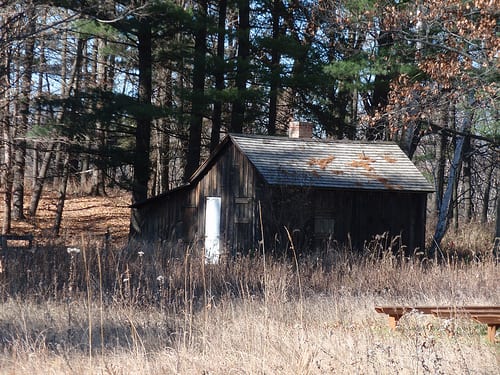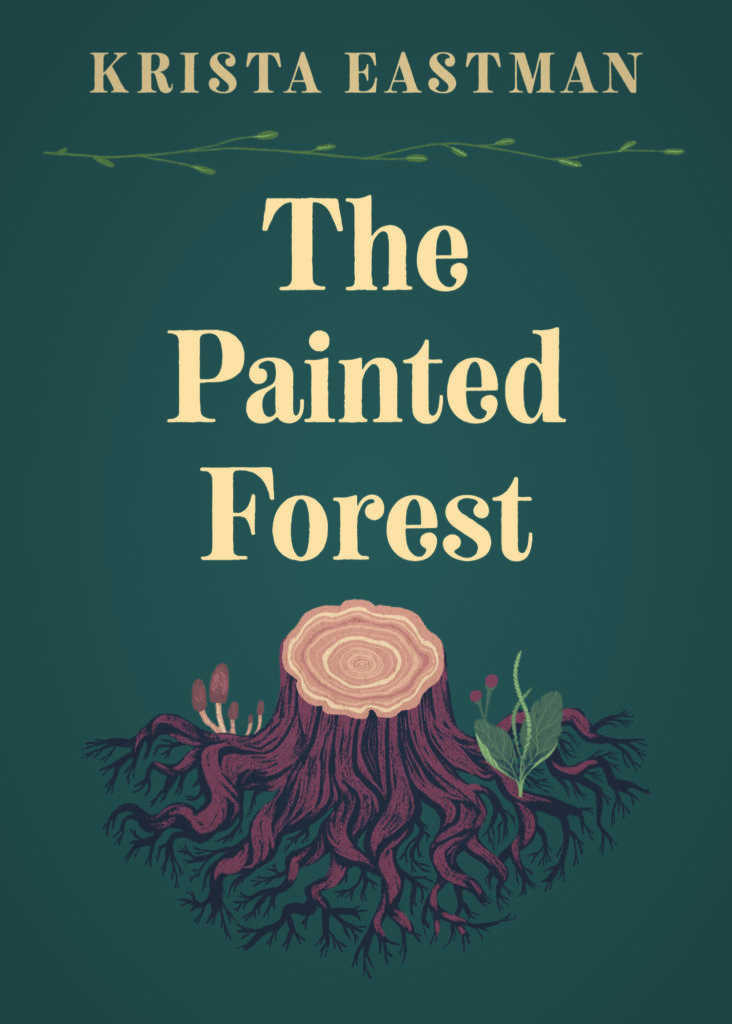
By Krista Eastman
West Virginia University Press published Krista Eastman’s The Painted Forest this month. She will appear at several events to launch the collection of essays, including the Wisconsin Book Festival on October 19 and Boswell Book Company on October 29. More details about the events can be found here. The below is an excerpt from “Insider’s Almanac,” the second essay in the book, followed by a Q&A. “Insider’s Almanac” was originally published in 2012 by The Georgia Review. This year marks the 70th anniversary of the publication of Aldo Leopold’s A Sand County Almanac, which Krista Eastman considers below.
The girl version of myself, in her search to trace origins, couldn’t get much further than the county line, and so she became first a fixture at the town’s public library, then a traveler. And yet, local girl, avid reader, I never picked up A Sand County Almanac, the classic born just miles from my hometown, and I don’t recall learning about it in school. My copy of Leopold’s book, acquired in adulthood and in the spirit of research, smells of press and crispness, its pages not dog-eared nor tattered nor steeped in the oil found on fingertips. This almanac does not occupy my nightstand, has never been the binding I chose to brush up against in the dark, nor the words I intoned while on pilgrimage through the woods alone. But it has haunted me.
A Sand County Almanac is part lyric manifesto, but it does much more than merely conjure up the natural beauty of Leopold’s farm.
 Reading A Sand County Almanac, I learned that Aldo Leopold made another kind of map of this place, providing the vocabulary for another way of looking at the world by transcribing the messages he found written on wind, dew, and pine with poetry and a pithy common sense. “There are some who can live without wild things, and some who cannot,” he begins simply. “These essays are the delights and the dilemmas of one who cannot.” And these words, like much of A Sand County Almanac, twist my thoughts. Arriving a little late to this book, this particular county, I must entertain my own share of new and uncomfortable questions, my own delights and dilemmas. Raised among open fields and cultivated hills, how will I be sure that I can or cannot live without these wild things, which I do not identify and cannot always see? I underline words such as Silphium and bur oak and wonder if these plants are still around. Have they been around all this time? Do they survive in the unharvested corners of farmland whose cultivated verdure most certainly plays me for a fool, prompting me to gaze as one gazes at the back of one’s own hand, carelessly, with few questions?
Reading A Sand County Almanac, I learned that Aldo Leopold made another kind of map of this place, providing the vocabulary for another way of looking at the world by transcribing the messages he found written on wind, dew, and pine with poetry and a pithy common sense. “There are some who can live without wild things, and some who cannot,” he begins simply. “These essays are the delights and the dilemmas of one who cannot.” And these words, like much of A Sand County Almanac, twist my thoughts. Arriving a little late to this book, this particular county, I must entertain my own share of new and uncomfortable questions, my own delights and dilemmas. Raised among open fields and cultivated hills, how will I be sure that I can or cannot live without these wild things, which I do not identify and cannot always see? I underline words such as Silphium and bur oak and wonder if these plants are still around. Have they been around all this time? Do they survive in the unharvested corners of farmland whose cultivated verdure most certainly plays me for a fool, prompting me to gaze as one gazes at the back of one’s own hand, carelessly, with few questions?
A Sand County Almanac is part lyric manifesto, but it does much more than merely conjure up the natural beauty of Leopold’s farm. Leopold also takes up the problem of perception, of how we perceive ourselves and the land we make our own—and the ethics of both of those things at once. In the chapter entitled “December,” Leopold writes: “The wild things that live on my farm are reluctant to tell me, in so many words, how much of my township is included within their daily or nightly beat. I am curious about this, for it gives me the ratio between the size of their universe and the size of mine, and it conveniently begs the much more important question, who is the more thoroughly acquainted with the world in which he lives?”
Fueled by local affiliation, I approach this book with the same question, though mine conceals a different kind of curiosity. With sheepishness, I wonder about my mythic Leopold and myself, about the size of our two universes in this same Wisconsin county. I admit that asking the question this way risks placing the book in my hands at a perverse angle, exposing my interest as a brutish desire to defend, or to stake my own claim.
Arriving a little late to this book, this particular county, I must entertain my own share of new and uncomfortable questions, my own delights and dilemmas.
Leopold, measured and wise, continues: “Like people, my animals frequently disclose by their actions what they decline to divulge in words. It is difficult to predict when and how one of these disclosures will come to light.”
Perhaps I should also decline to put into words the insularities of my own habitat. Like the many who’ve come before, perhaps I should brush off clear declarations in favor of physical work, express myself only with silent necessity—with eyes that know but hold back, with a stolid distaste for the process of explaining and, worse yet, of being explained. And yet disclosures have already been made, squatting with imperfection on my page and under my name. That made-up memory of the sweat spot I stood long enough to admire, has emboldened me somehow, causing me to speak almost by accident of another universe, another definition of local, the many ways you can wed yourself to land. Here I admit to animal behavior.
Q&A with Krista Eastman
 1. When did you start writing The Painted Forest?
1. When did you start writing The Painted Forest?
I wrote the earliest essay, “Layers of Ice,” after having returned from working at McMurdo Station in Antarctica and while in my first year of graduate school, way back in 2008.
2. Do you find that your experience of living in many different places, from Senegal to Antarctica, affects you as a writer?
In a lot of ways, I think living and working abroad as I did in my 20s is what got me to commit seriously to writing and to literary nonfiction in particular. I began writing from other places and that experience helped me figure out how to write about home, or to hold the same fascination for the things in front of my nose as for the things I had gone to the end of the earth to find.
3. What brought you back to your home state of Wisconsin?
The official story is that I returned in 2010 when the U.S. economy was in the can because I knew I could get a job here. The unofficial story is that I had a fine case of burn out and wanted to be home for a while.
4. What’s your relationship to revision?
I actually revise as I go so that by the time I finish the “first draft” of an essay it’s usually about 98% done. Since we admire what other people have, I like to bitterly imagine other writers completing first drafts in fits of inspiration and then heading out to revel with each other at the neighborhood bar. What I do is suck on coffee, pinch up my face, and then move the text an inch or two a day until it’s done.
5. How did you choose which influences to explore and name?
There’s not much method to this, I’m afraid. What I love about writing is that I can justify exploring any interest I have. I can check out an embarrassingly broad spectrum of books from the library and not have to answer for it. I have my secret art and I don’t (and won’t) explain it. Some things I write don’t require much research. But for most of it I do read quite a bit, for background or context or to be privy to what experts are saying about X. I’ll read anything, even books I barely understand, because I’m trying to make sense of something. My writing almost always begins with a question of some kind, even if at first it’s barely formed.
6. Have you always been drawn to writing about place and the environment?
I don’t think of myself as someone who writes about the environment, at least not directly. I’ve always been drawn to thinking about storytelling and about how we humans create place-based identities for ourselves. I’m kind of obsessed with how we make the world through perception and that includes concerns about our relationship to the earth.
But of course I am extremely worried about our climate crisis. The challenge for me has been how to capture and make something from the cascading ills of this moment – from the wild precariousness, the cruelty, and the astonishingly unequal distribution of wrongs.
7. Could you tell us about your next work, Pionier?
I don’t really like to talk about work while it’s in progress, but you can read some of it – an essay called “Ancient Inland Sea” – this fall in the “Earth Elegies” issue of Conjunctions.
Krista Eastman‘s writing has earned recognition from Best American Essays and appeared in The Georgia Review, The Kenyon Review (KROnline), New Letters, and other journals. She lives in Madison, Wisconsin. For more information, please visit her website kristaeastman.com.
